There are so many reasons to love indoor plants. They add color and liven up shabby spaces, and they can even boost your mood and filter out indoor air pollutants! With all those benefits, it’s no wonder why so many people choose to keep a plant or two in their office.

However, not all plants are well-suited for office environments. In this guide, we’ll introduce you to some of the best easy-care plants to add color to your cubicle and cheer up your home office. With all these fun plants to choose from, we know you’ll find the right indoor plant for you!
Jump to:
- How to choose the right plant for your office?
- 18 easy-care plants for your office
- 1. Snake plant (Dracaena trifasciata)
- 2. ZZ plant (Zamioculcas zamiifolia)
- 3. Pothos (Epipremnum aureum)
- 4. Lucky bamboo (Dracaena sanderiana)
- 5. Air plants (Tillandsia spp.)
- 6. Spider plant (Chlorophytum comosum)
- 7. Rubber plant (Ficus elastica)
- 8. Ponytail palm (Beaucarnea recurvata)
- 9. Arrowhead vine (Syngonium podophyllum)
- 10. Cacti
- 11. Philodendron (Philodendron spp.)
- 12. Chinese evergreen (Aglaonema commutatum)
- 13. Parlor palm (Chamaedorea elegans)
- 14. Cast iron plant (Aspidistra elatior)
- 15. Peace lily (Spathiphyllum wallisii)
- 16. African violet (Saintpaulia Ionantha)
- 17. Succulents
- 18. Dwarf umbrella tree (Schefflera arboricola)
- Frequently asked questions
- Summary
How to choose the right plant for your office?
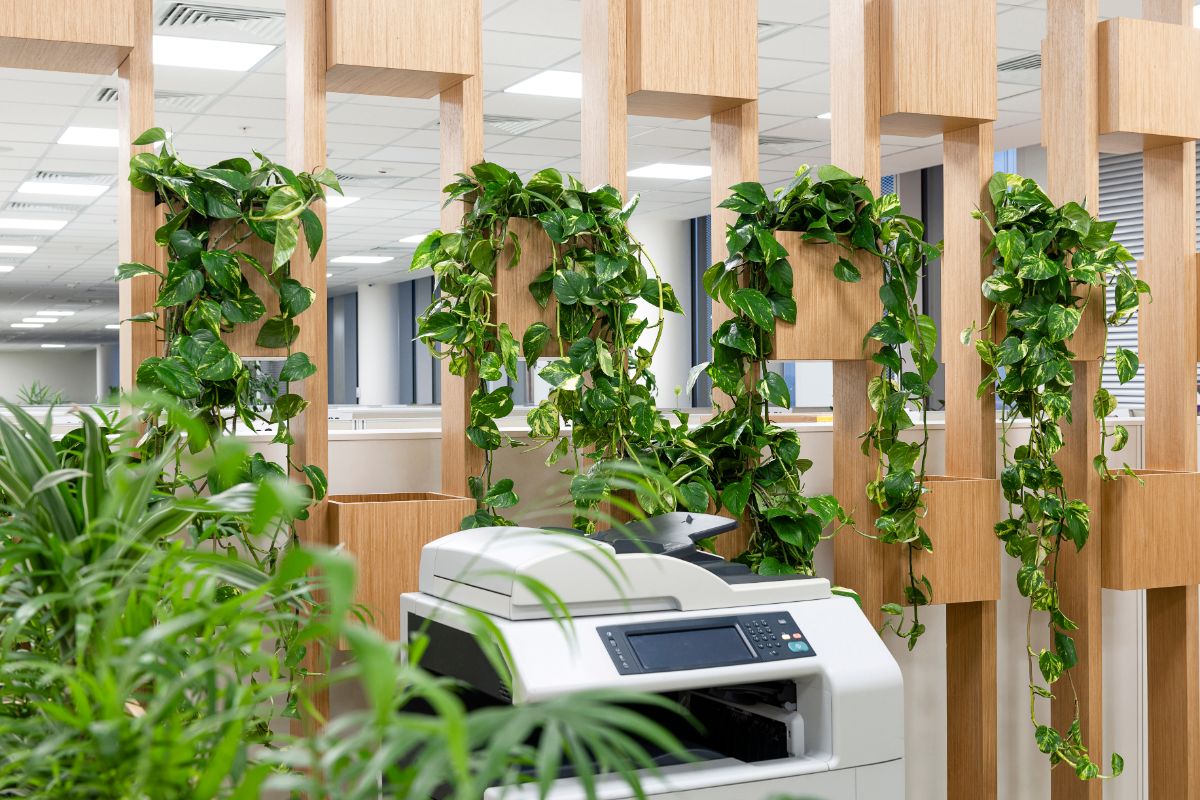
Which plants will work in your office will depend on several factors.
- How much light does your office receive? Does your office have a sunny window or no windows at all?
- Is the air in your office really dry?
- How much space do you have for plants?
- Are you in your office often, or do you travel frequently?
Considering these questions will help you pick the right plant for your space.
In general, the best plants for offices are hardy, low-maintenance plants that can handle lower light settings. If plants can manage with minimal watering and low humidity levels, that’s even better!
18 easy-care plants for your office

From succulents to tropical plants, we’ve included a wide variety of indoor office plants in the list below. Some of these plants are known for their colorful foliage, while others flower reliably throughout the year. Regardless of your tastes, you’re sure to find an indoor plant or two that will be perfectly suited for your workspace!
1. Snake plant (Dracaena trifasciata)
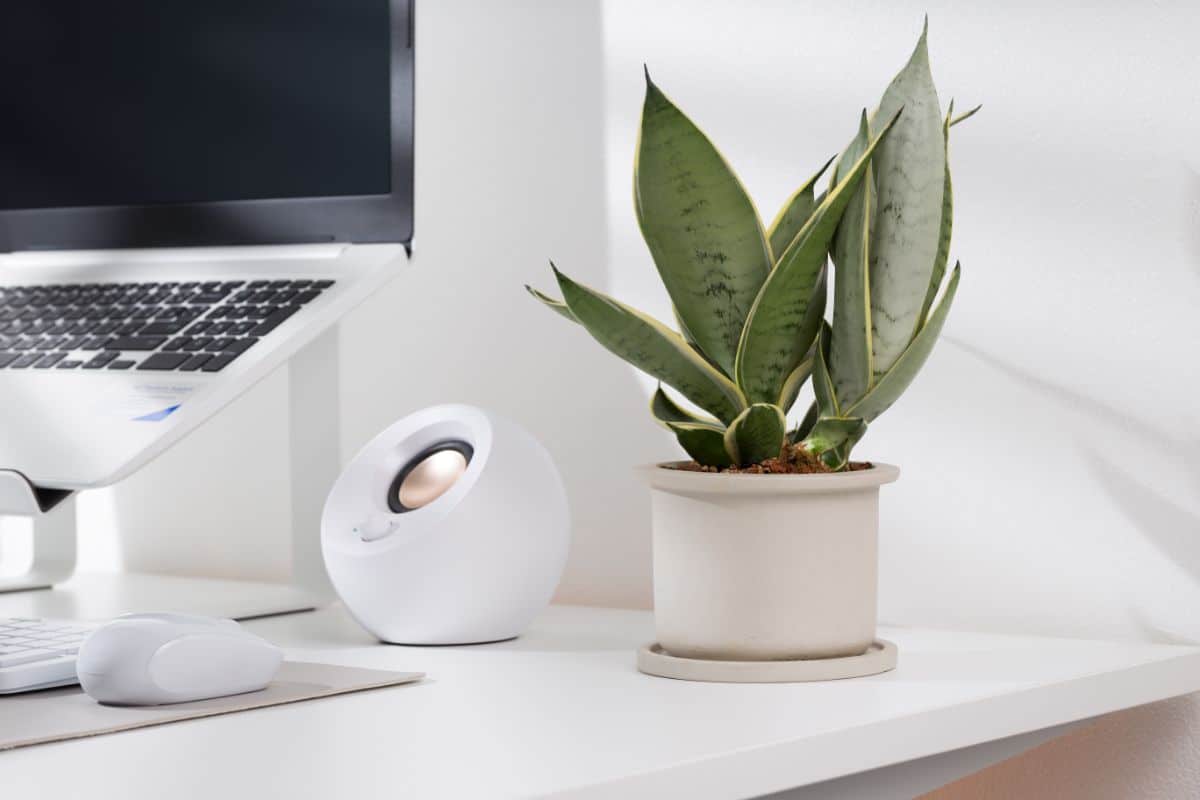
| Plant name: | Snake plant |
| Light requirements: | Bright light to low light |
| Water requirements: | Low |
| Size: | Medium |
| Special features: | Low light; Low water; May flower in bright light; Indoor air purification |
Also known as “mother in law’s tongue” due to its spiky leaves, the snake plant is a hardy, no-fuss species that are perfect for office settings. As a succulent, snake plant has low watering needs, so it’s no big deal if you forget to water it for a few weeks. Snake plants also handle low-humidity environments like champs, and they won’t mind dry indoor air during the winter months.
One of the major benefits of snake plants is that these plants can handle lower-light situations. However, although snake plants can grow in shadier spots, they will do better with plenty of sun and may even flower. Snake plants come in many varieties, including species with colorful, variegated leaves, as well as round or flat leaf shapes.
2. ZZ plant (Zamioculcas zamiifolia)
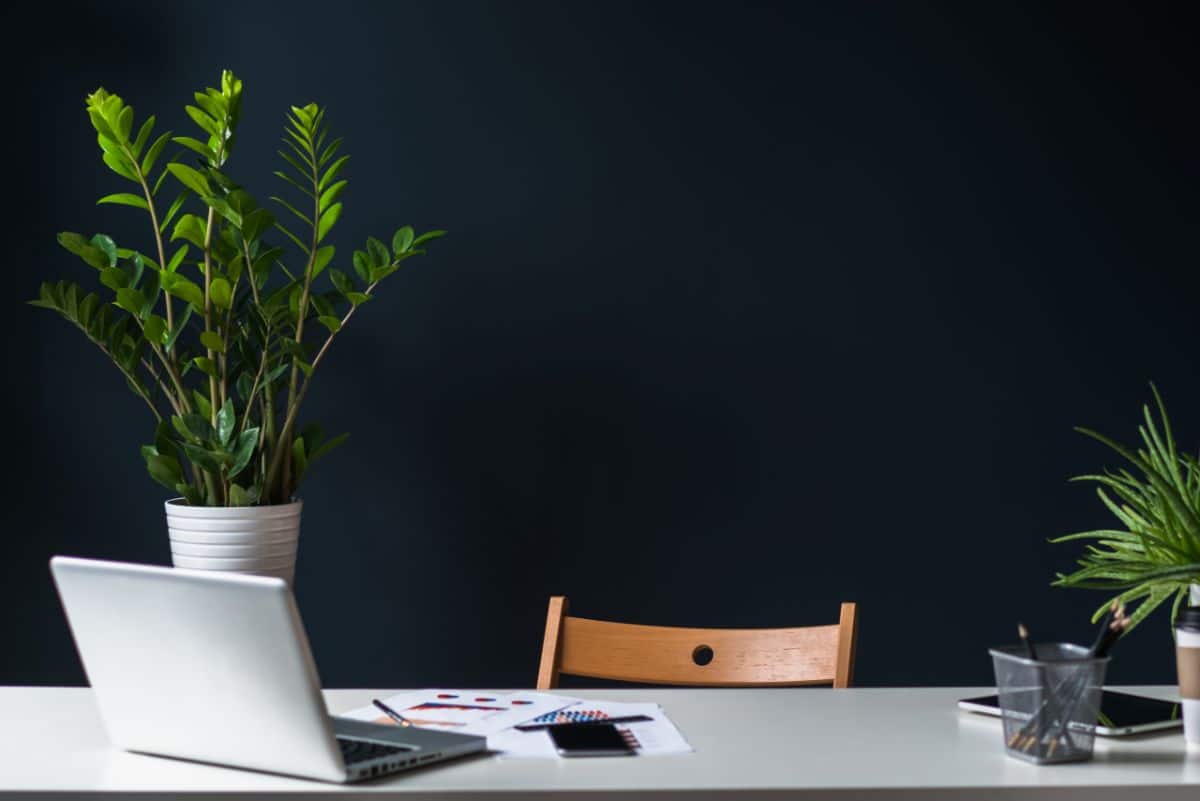
| Plant name: | ZZ plant |
| Light requirements: | Bright, indirect light |
| Water requirements: | Low |
| Size: | Medium |
| Special features: | Low light; Low water |
Another hardy succulent species, ZZ plants, only need to be watered every 2 to 3 weeks (or even less!), which makes them a good choice if you travel often and aren’t in your office all the time. These plants also prefer bright, indirect light, and they can grow happily in fluorescent lighting, which is so common in office environments.
Since ZZ plants are toxic to pets, it can be a much safer option to grow these plants in a pet-free office than in your home. While you can find ZZ plants with rich, green leaves, for even more variety, look for “Raven” ZZ plant. This hugely popular cultivar has dark, near-black foliage!
3. Pothos (Epipremnum aureum)
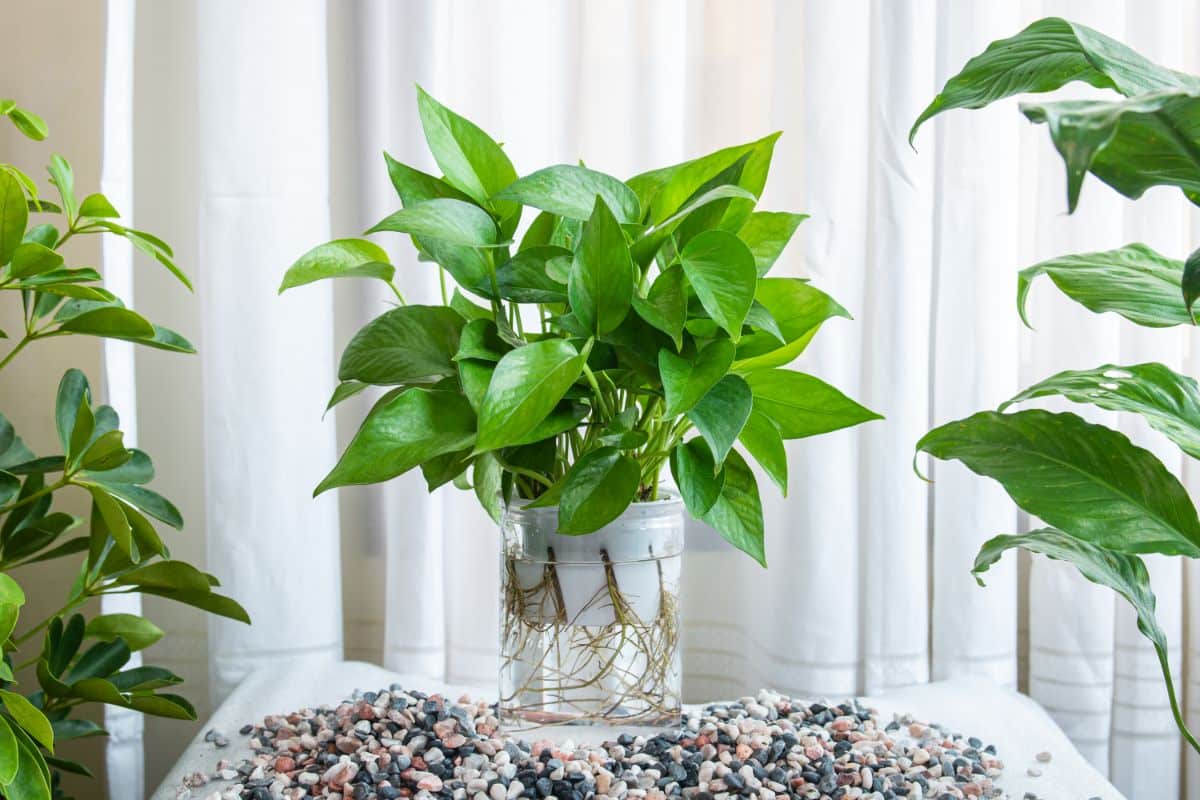
| Plant name: | Pothos |
| Light requirements: | Bright, indirect light to low light |
| Water requirements: | Moderate |
| Size: | Medium – can grow up to 60’ long if allowed to vine |
| Special features: | Vines can be trained vertically; Many varieties to choose from; Can be kept in water; Propagates easily; Indoor air purification |
Also known as “devil’s ivy” due to its nearly indestructible nature, pothos is one of the best indoor plants to grow if you’re new to keeping plants. This resilient plant can handle a wide range of conditions, including medium to low-light office settings. As a vining plant, pothos can be kept in hanging baskets or trained to crawl up vertical poles if you don’t have a lot of desk space.
Pothos is also one of the few plants that you can keep in water, which can be a tidier option if you don’t want to deal with soil on your desk. You can find pothos in lots of different colors, including neon pothos, golden pothos, and marble queen pothos.
4. Lucky bamboo (Dracaena sanderiana)
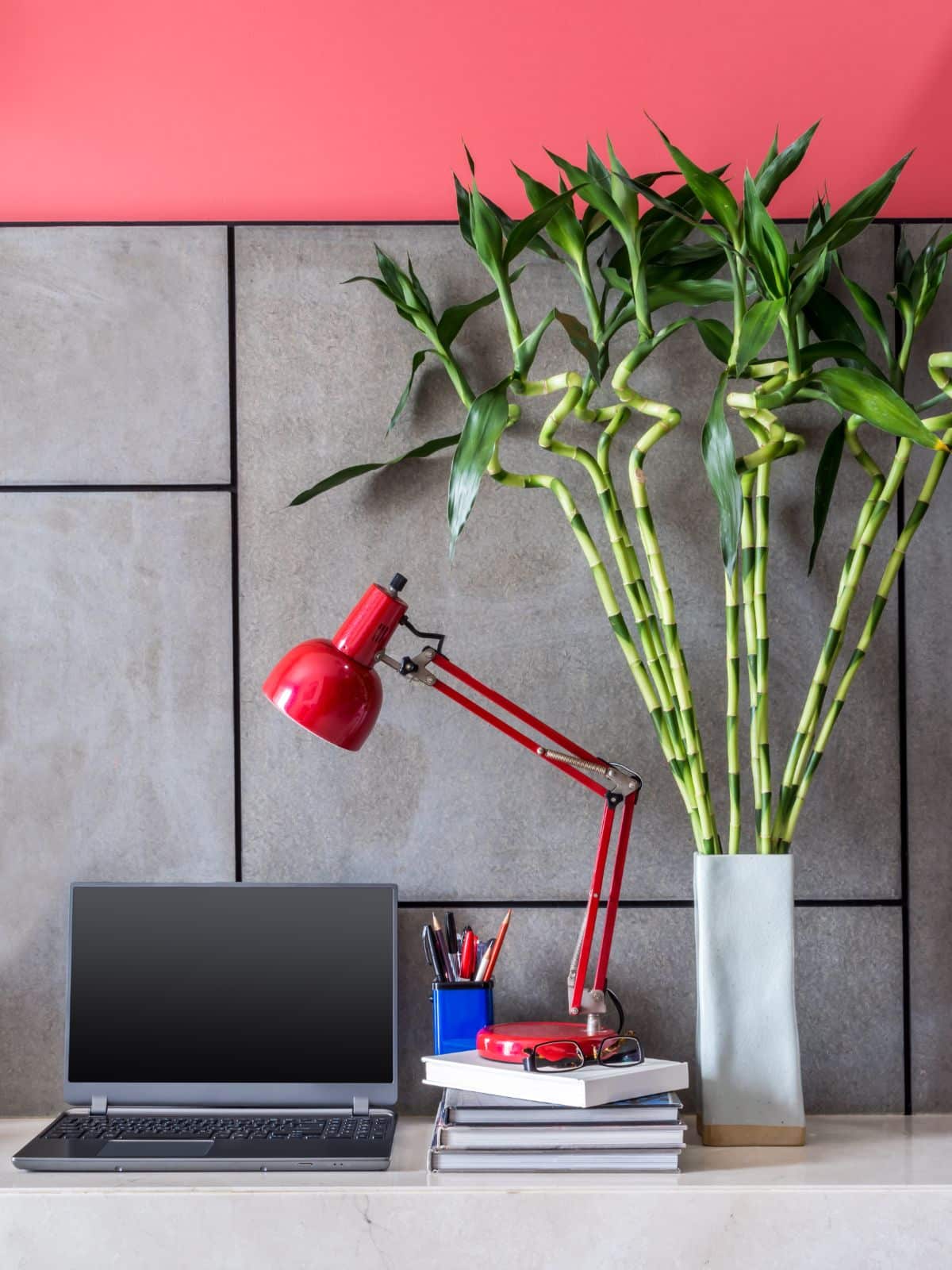
| Plant name: | Lucky bamboo |
| Light requirements: | Bright, indirect light |
| Water requirements: | Moderate |
| Size: | Medium |
| Special features: | Can be kept in water; Highly symbolic plant |
Despite its name, lucky bamboo isn’t actually bamboo; however, its knobby stems have a bamboo-like appearance. This plant is a variety of dracaena and is closely related to other dracaena species, like corn plants and dragon trees.
Lucky bamboo gets its name from traditional Feng Shui, which asserts that this plant confers good luck and fortune on its owner. While we can’t guarantee that lucky bamboo will bring prosperity to your office, it certainly can’t hurt! Beyond that, lucky bamboo is also a charming and adaptable plant that can be grown in both water and soil.
5. Air plants (Tillandsia spp.)
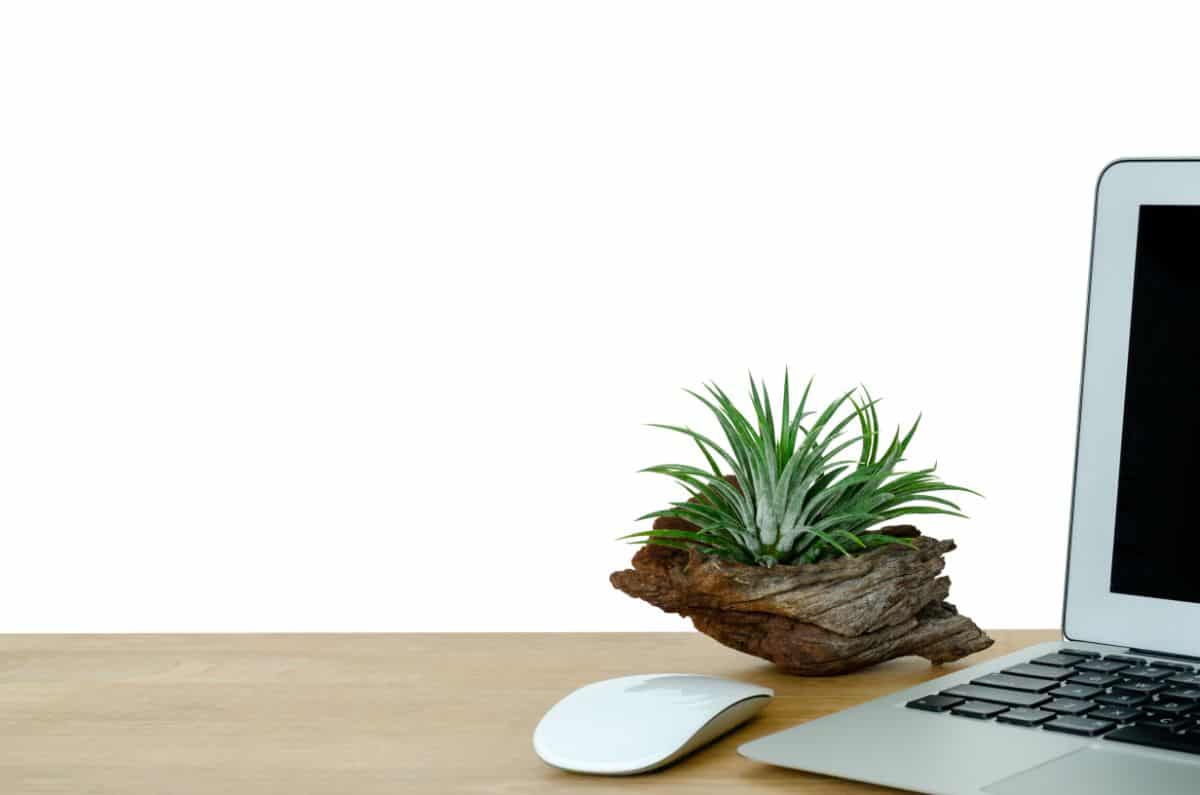
| Plant name: | Air plants |
| Light requirements: | Bright, indirect light |
| Water requirements: | Moderate |
| Size: | Small |
| Special features: | Very small space friendly; Many varieties to choose from; Will flower |
Air plants are one of the most no-fuss plants you can find. Most air plant species don’t need any soil to grow, and they can get most of the nutrients and water they need from the air around them. What’s more, air plants just need to be spritzed with moisture or dunked in a bowl of water from time to time to hydrate them.
If you have a small office, air plants are a top pick. Most air plant species are very small and can fit right on top of your computer monitor! When mature, air plants will also produce a showy, purple, and red flower that’s certain to be the talk of your office for days.
6. Spider plant (Chlorophytum comosum)
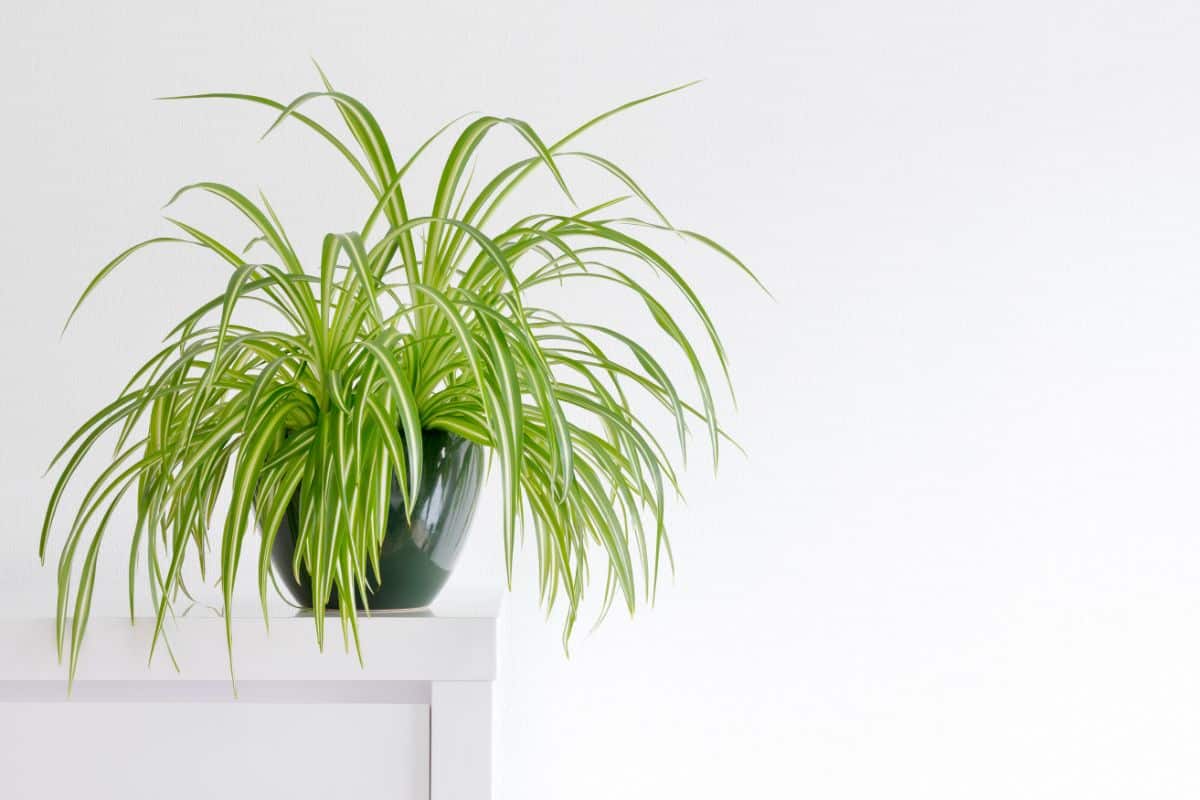
| Plant name: | Spider plant |
| Light requirements: | Bright, indirect light |
| Water requirements: | Moderate |
| Size: | Medium |
| Special features: | Will flower; Propagates easily; Indoor air purification |
Spider plants are known for their grass-like leaves that come in both solid green and variegated options. When mature, these plants produce a long stalk that eventually blooms with white flowers. When those flowers fade, new baby spider plants emerge, which can be separated from the parent plant and shared with coworkers!
A beginner-friendly plant, the spider plant has moderate watering needs, and it can grow well in average humidity levels. Another great option for lower-light offices, the spider plant prefers low to medium light, and it can be kept under grow lights too.
7. Rubber plant (Ficus elastica)
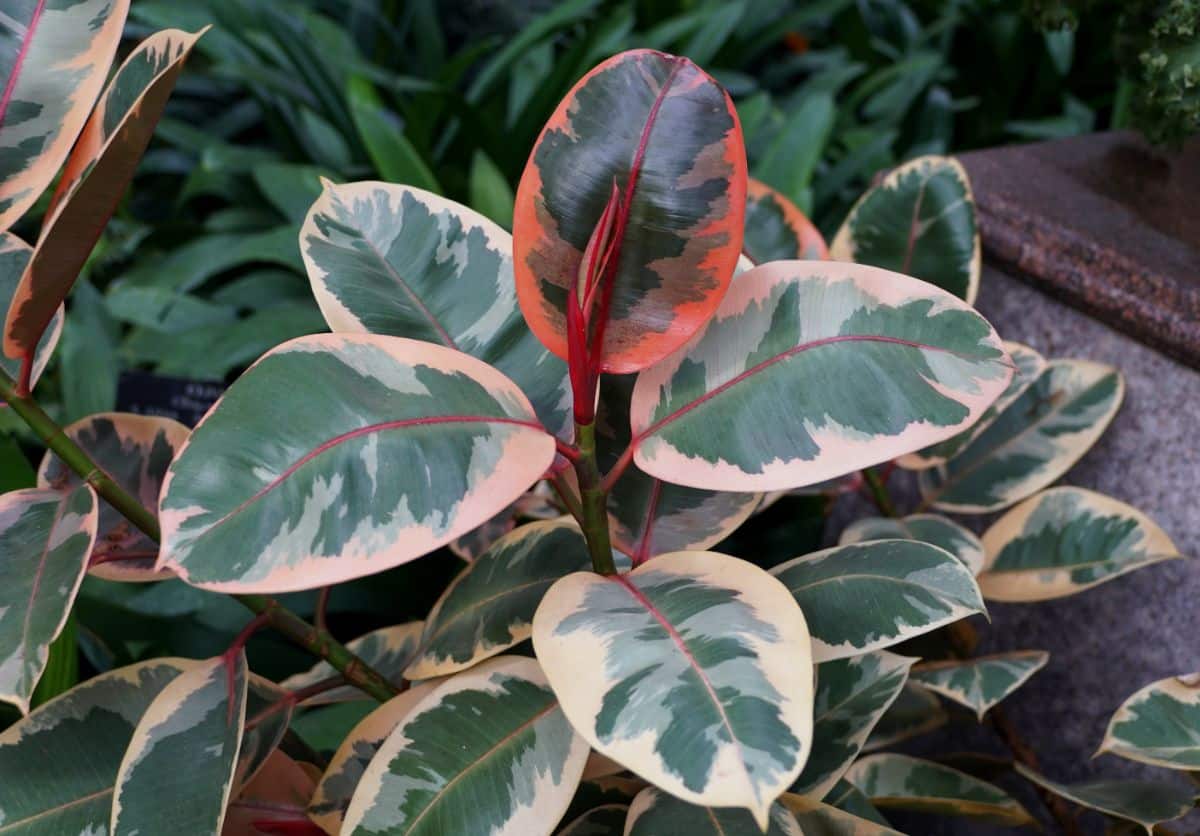
| Plant name: | Rubber plant |
| Light requirements: | Bright, indirect light |
| Water requirements: | Moderate |
| Size: | Large to medium |
| Special features: | Colorful leaf sheaths; Great for lobbies; Indoor air purification |
Rubber plants are often seen in office environments and lobbies, where they lend a tropical feel and lots of bright colors to the space around them. These plants are named for the white latex sap that they produce when injured; however, they are a different species from true rubber trees (Hevea brasiliensis).
Rubber trees have large, glossy leaves that come in both solid green and variegated options. When leaves first emerge, they unfurl from a bright red leaf sheath, which can be interesting to watch. Most rubber trees are purchased as tabletop plants, but they can grow up to 6 to 10’ tall indoors.
8. Ponytail palm (Beaucarnea recurvata)
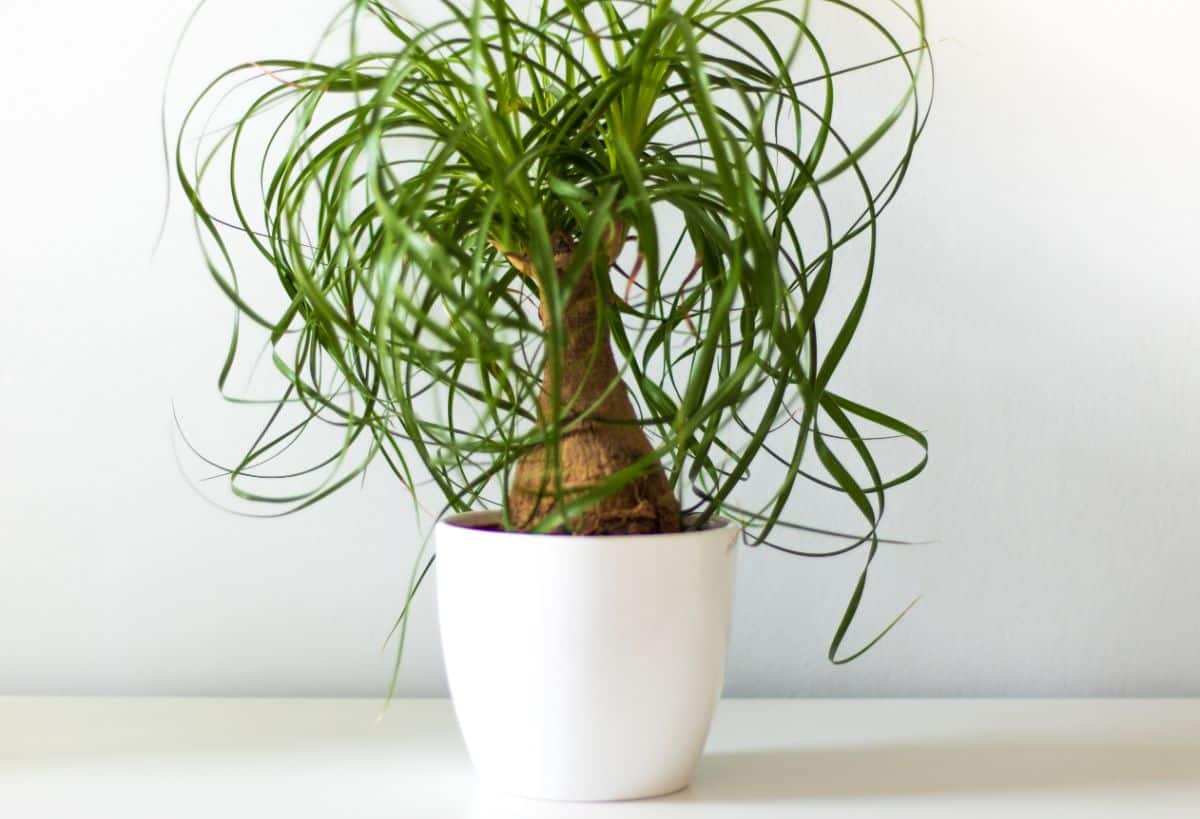
| Plant name: | Ponytail palm |
| Light requirements: | Bright light |
| Water requirements: | Low |
| Size: | Large to medium |
| Special features: | Low water |
Ponytail palm isn’t a palm at all, but it’s actually a member of the Agave family and hails from Mexico! This curious-looking plant is well known for its bulbous stem and curly leaves. That stem serves a purpose, though -- it enables the plant to store water and resist drought.
Ponytail palms require bright light, and they should be located near a window. If your office doesn’t have a window, you can also keep these plants happy with a grow light. Set your grow light on a timer to provide your ponytail palm with at least 8 hours of light daily.
9. Arrowhead vine (Syngonium podophyllum)
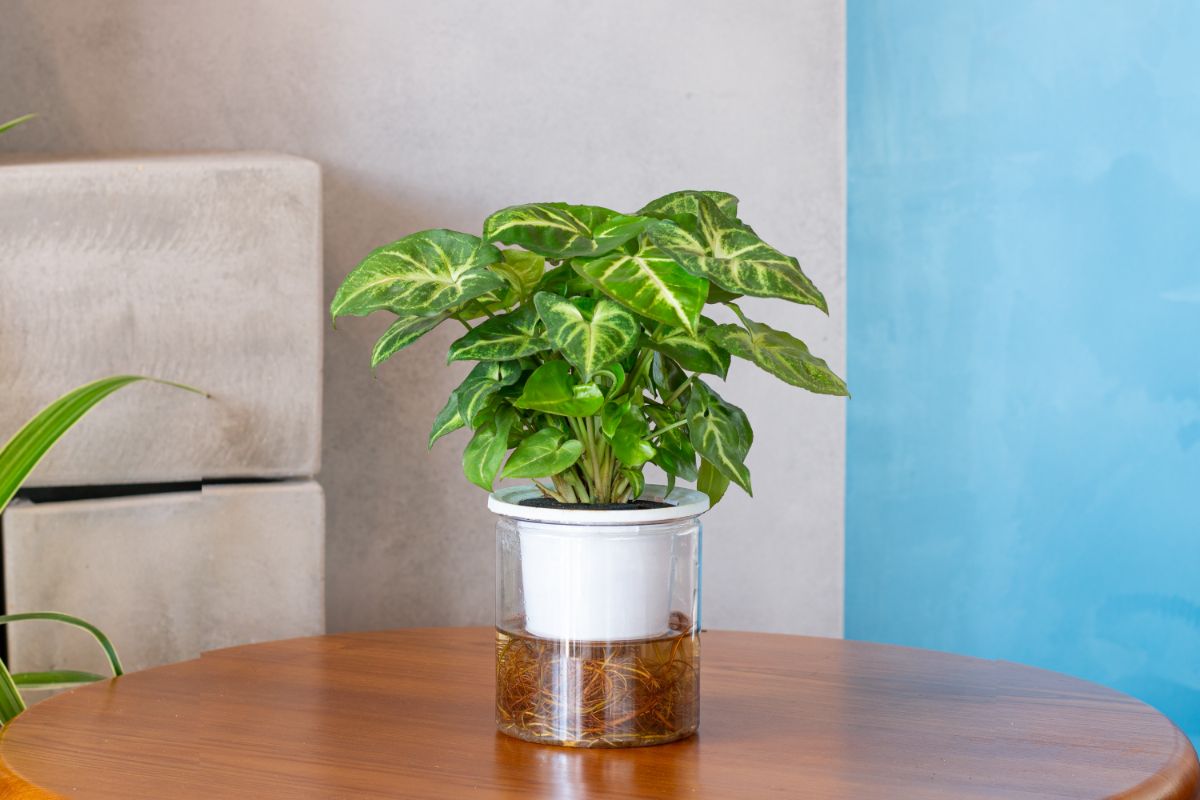
| Plant name: | Arrowhead vine |
| Light requirements: | Bright, indirect light to low light |
| Water requirements: | Moderate |
| Size: | Medium |
| Special features: | Can be trained to grow vertically; Propagates easily |
Arrowhead vines are native to South America and naturally have a climbing growth habit. You can train these plants to grow up small trellises or moss poles, or you can leave them to grow a bit wild. For a more tidy look, prune your arrowhead vines regularly and put the cuttings in water to propagate new plants.
Arrowhead vines most often have green, arrow-shaped leaves, although you can find cultivars with pink or variegated foliage. These beginner-friendly plants prefer bright, indirect sunlight, but they can also handle lower-light offices. If you’d like to grow a few different plants in a single pot, arrowhead vines, and pothos have similar care requirements and can grow well together.
10. Cacti

| Plant name: | Cacti |
| Light requirements: | Bright light (most species) |
| Water requirements: | Low |
| Size: | Large to small |
| Special features: | Low water; Many varieties to choose from; May flower |
Cacti are famous for their ability to thrive in low-water situations, so if you travel a lot or often forget to water your plants, cactuses can be a good choice. These desert dwellers only need to be watered every few weeks during the growing season, and some species can even go several months without water during winter. To avoid issues with root rot, only water your cactuses when the soil is completely dry.
Most cactus species prefer bright light and should be located in a window or under a grow light. There are many different cactus varieties to choose from, including small tabletop specimens and larger floor plants. Some of the most popular cactuses include moon cacti, golden barrel cacti, and bunny ear cacti.
11. Philodendron (Philodendron spp.)

| Plant name: | Philodendron |
| Light requirements: | Bright, indirect light (may vary depending on species) |
| Water requirements: | Moderate |
| Size: | Medium |
| Special features: | Some species can be trained to grow vertically; Some species propagate easily; Indoor air purification |
There are hundreds of different types of philodendrons available today, and some are better suited to office environments than others. Some popular philodendron species, like the split-leaf philodendron, can work in offices, but they can be more demanding plants. These species grow best with bright, indirect light, regular watering, and higher humidity levels.
For lower maintenance options, vining philodendrons such as the heartleaf philodendron or the velvet leaf philodendron can be good choices. These plants have similar growing needs to pothos and easily propagate in water. Place these plants in the bright, indirect sun for the best results.
12. Chinese evergreen (Aglaonema commutatum)
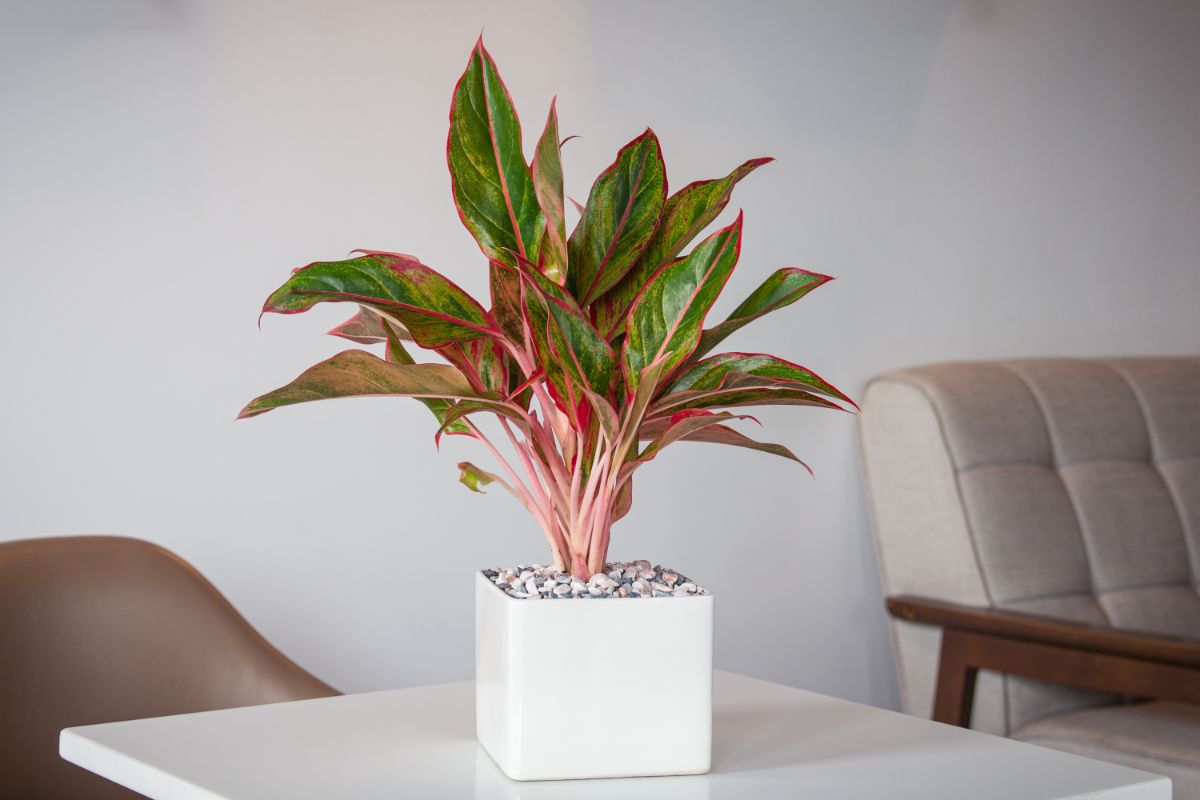
| Plant name: | Chinese evergreen |
| Light requirements: | Bright, indirect light to low light |
| Water requirements: | Moderate |
| Size: | Medium |
| Special features: | Low light; Colorful foliage; Indoor air purification |
If you love colorful foliage plants, Chinese evergreens are hard to beat. These plants come in a variety of colors, although the red and silver cultivars are particularly striking. Despite their impressive look, Chinese evergreens are low-maintenance plants and make spectacular additions to office environments.
When NASA conducted its famous Clean Air Study in 1989, it identified Chinese evergreens as one of the best plants for purifying indoor air. These plants can remove benzene, formaldehyde, and other pollutants that can be released from office furniture and carpets. And if you need more reasons to try out these plants, they can grow in low-light offices too!
13. Parlor palm (Chamaedorea elegans)
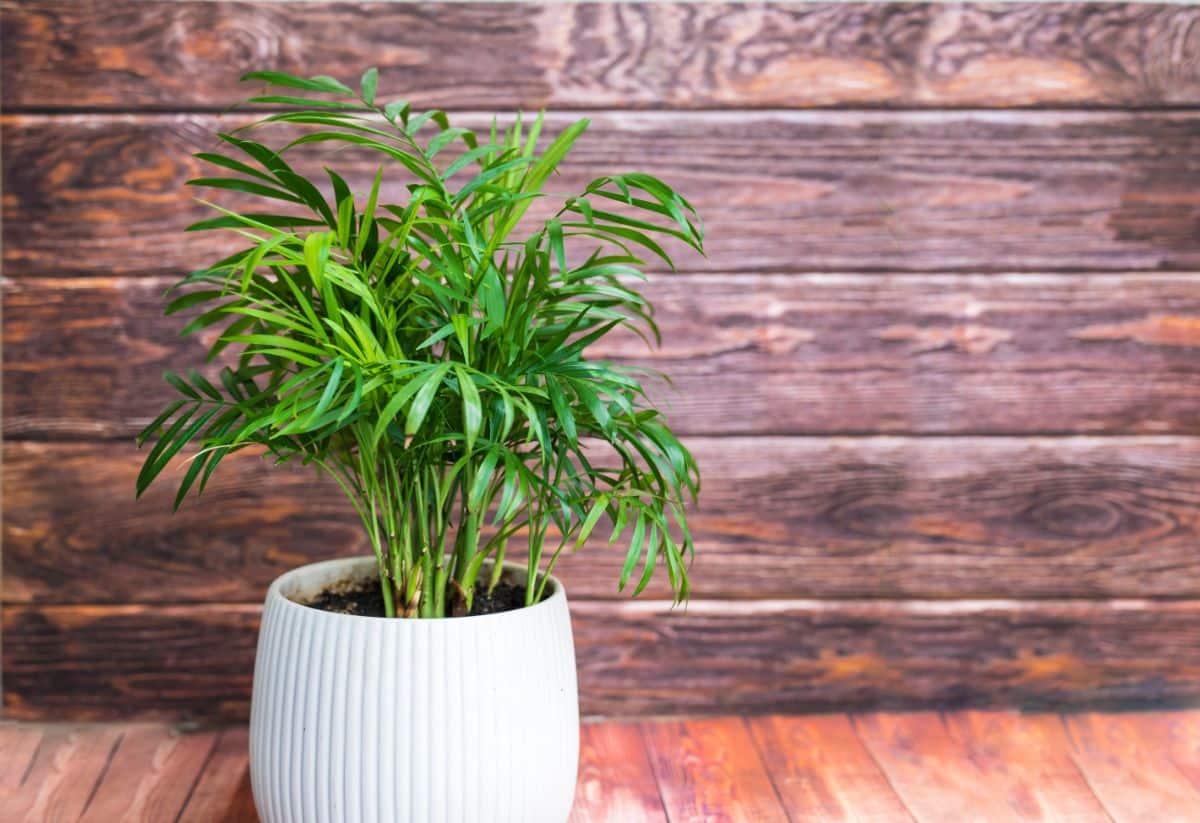
| Plant name: | Parlor palm |
| Light requirements: | Bright, indirect light |
| Water requirements: | Moderate |
| Size: | Large |
| Special features: | Great for lobbies |
Palms are elegant plants that add a touch of class and a traditional feel to any decor. However, due to their size and care requirements, not all palms are appropriate for office settings. But parlor palms are adaptable plants that can be ideal for your workspace.
Parlor palms generally grow between 4 to 8’ tall, which makes them appropriate for both offices and lobby spaces. Unlike some other palms, parlor palms don’t like bright light, and too much sun can cause leaf burn. Just keep in mind that parlor palms do need a bit more humidity than some of the other plants on this list, and they may develop brown leaf tips if your office air is very dry.
14. Cast iron plant (Aspidistra elatior)
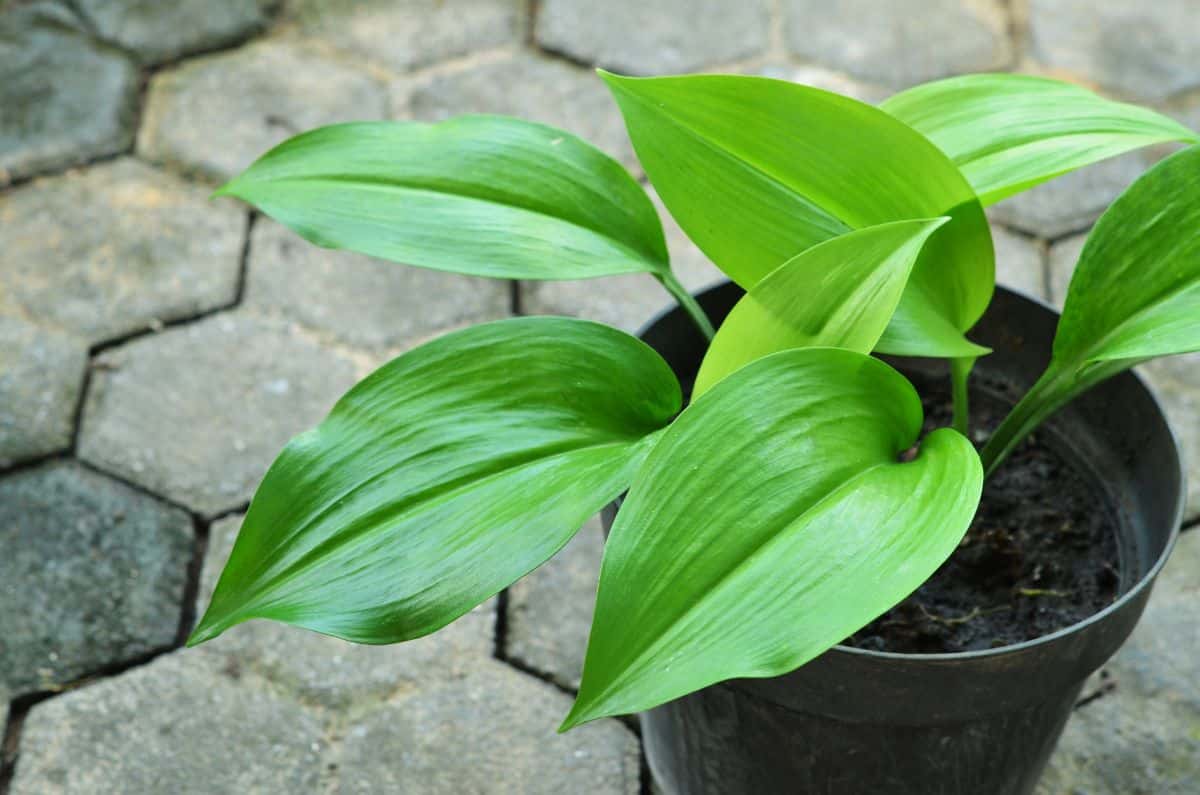
| Plant name: | Cast iron plant |
| Light requirements: | Medium to low light |
| Water requirements: | Moderate |
| Size: | Medium |
| Special features: | Low light |
Cast iron plants aren’t the most colorful plants on this list, but if you’re looking for a reliable and hardy office plant, they are a perfect pick. As their name suggests, cast iron plants are resilient and nearly indestructible! They can grow in low light settings and usually adapt to average indoor humidity levels, although they may grow a bit better with a pebble tray.
Cast iron plants became very popular during the Victorian period when they were used to add a bit of green to parlors and sitting rooms. Today, cast iron plants create a more welcoming office with their richly colored, lanciform leaves and easygoing nature.
15. Peace lily (Spathiphyllum wallisii)
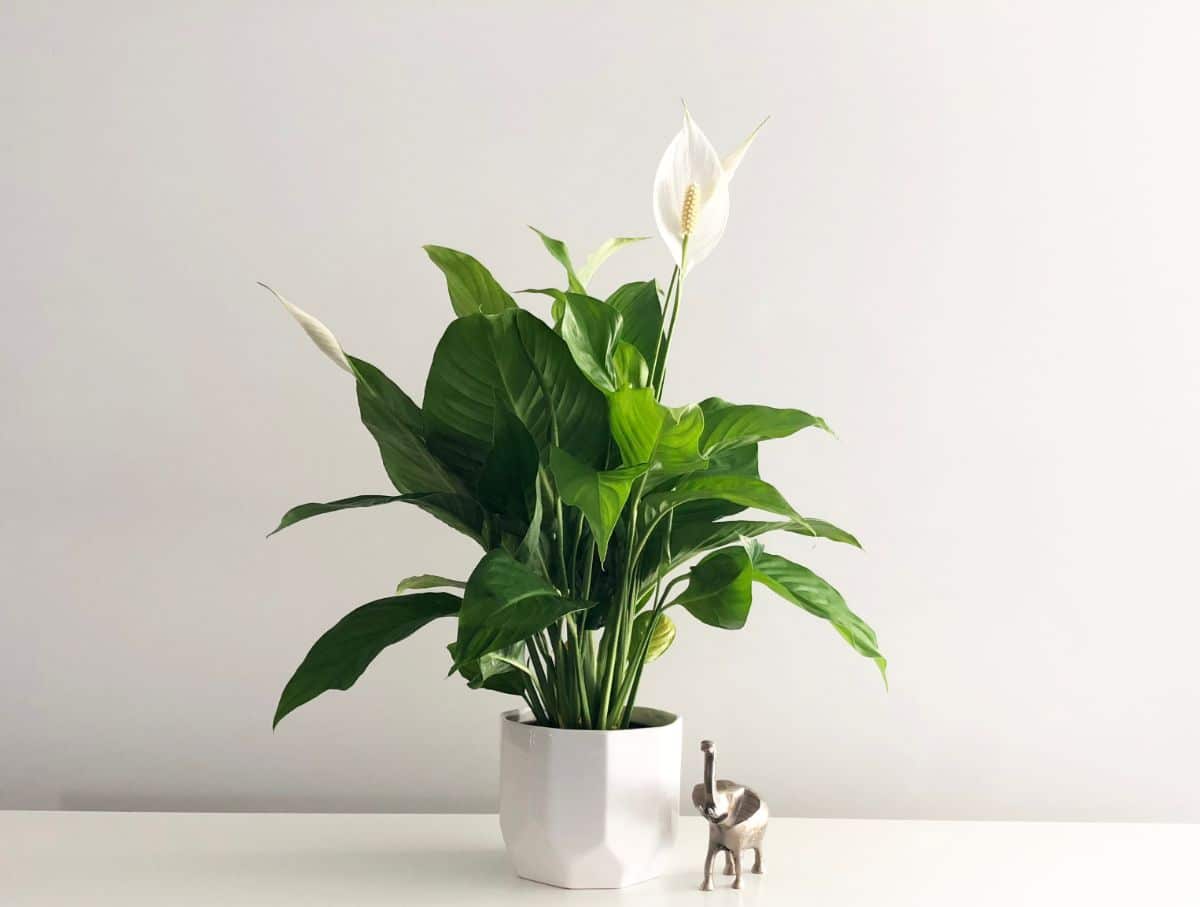
| Plant name: | Peace lily |
| Light requirements: | Bright, indirect light to low light |
| Water requirements: | High to moderate |
| Size: | Medium |
| Special features: | Will flower; Indoor air purification |
Peace lilies are common indoor plants that slightly resemble cast iron plants. However, peace lilies bloom much more often than cast iron plants do, and they are most famous for their elegant, white flowers.
Keeping peace lilies on your work desk can be a smart choice, as these plants are toxic to pets and are generally not safe to grow in homes with cats. Beyond their beauty, peace lilies are also well-known for their ability to purify indoor air. They can also grow in low-light situations, but they prefer slightly elevated humidity levels.
16. African violet (Saintpaulia Ionantha)

| Plant name: | African violet |
| Light requirements: | Bright, indirect light |
| Water requirements: | Moderate |
| Size: | Small |
| Special features: | Will flower; Furry leaves for fun texture |
African violets are charming, little plants that can’t help but put a smile on your face. When in bloom, African violets produce a profusion of colorful flowers that can range in tone from white and pink to purple and red. Flowers may have straight margins or frilly edges for even more excitement.
As small plants, African violets can easily fit on a windowsill or on the edge of your desk. While African violets are well known for their furry leaves, they don’t like getting their leaves wet. To avoid this, try keeping your African violet in a self-watering planter and water them from the bottom only.
17. Succulents
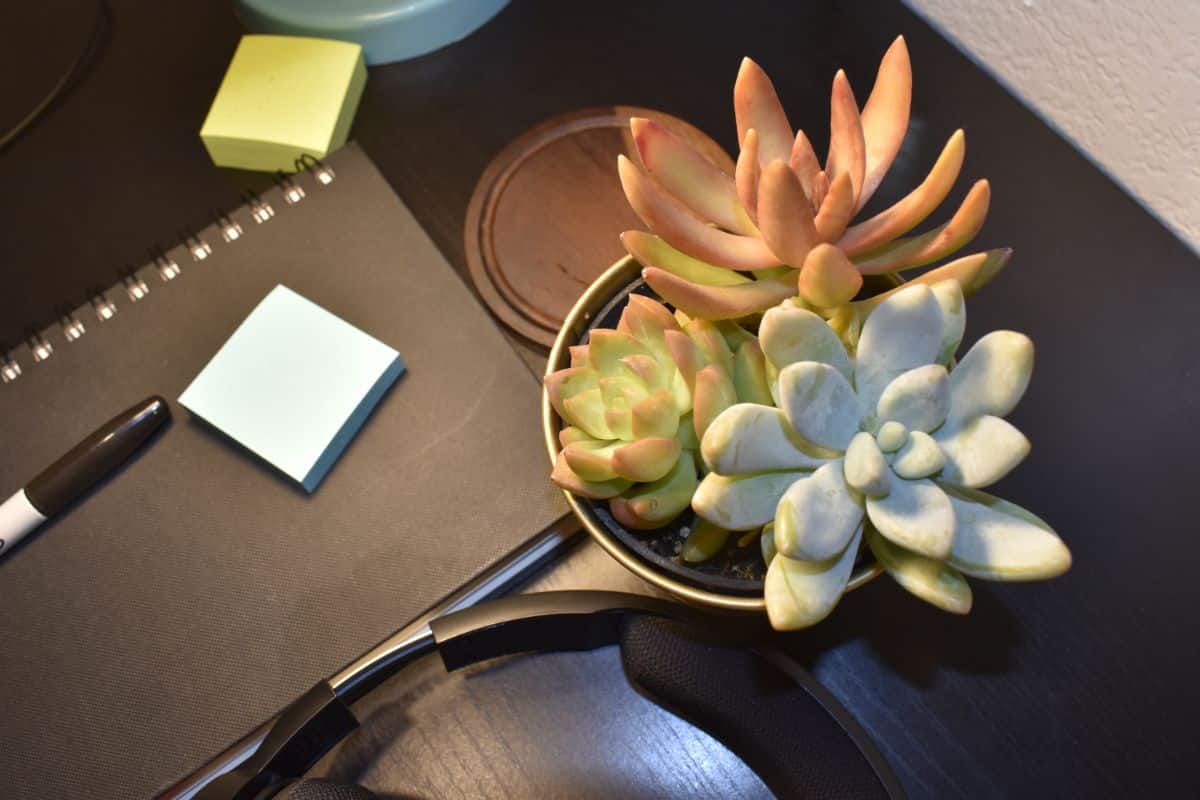
| Plant name: | Succulents |
| Light requirements: | Bright light (most species) |
| Water requirements: | Low |
| Size: | Small |
| Special features: | Low water; Some will flower; Some have colorful leaves |
ZZ plants and snake plants are two low-maintenance succulents, but there are lots of other succulents that will grow exceptionally well in most offices. Like cacti, succulents are drought-tolerant plants, and they don’t require much water. This makes them good choices for frequent travelers or for anyone who doesn’t plan on sticking to a regular watering schedule.
Succulents should only be watered when the soil is dry, and some growers wait to water until leaves begin to turn slightly soft and develop wrinkles. Most succulents prefer bright light and will get leggy if kept in dark rooms, but some species, like echeveria and haworthia, can be a bit more adaptable. One of the perks of keeping succulents is that many of these plants come in delightful colors, and they look particularly pretty when planted together in a large grouping.
18. Dwarf umbrella tree (Schefflera arboricola)
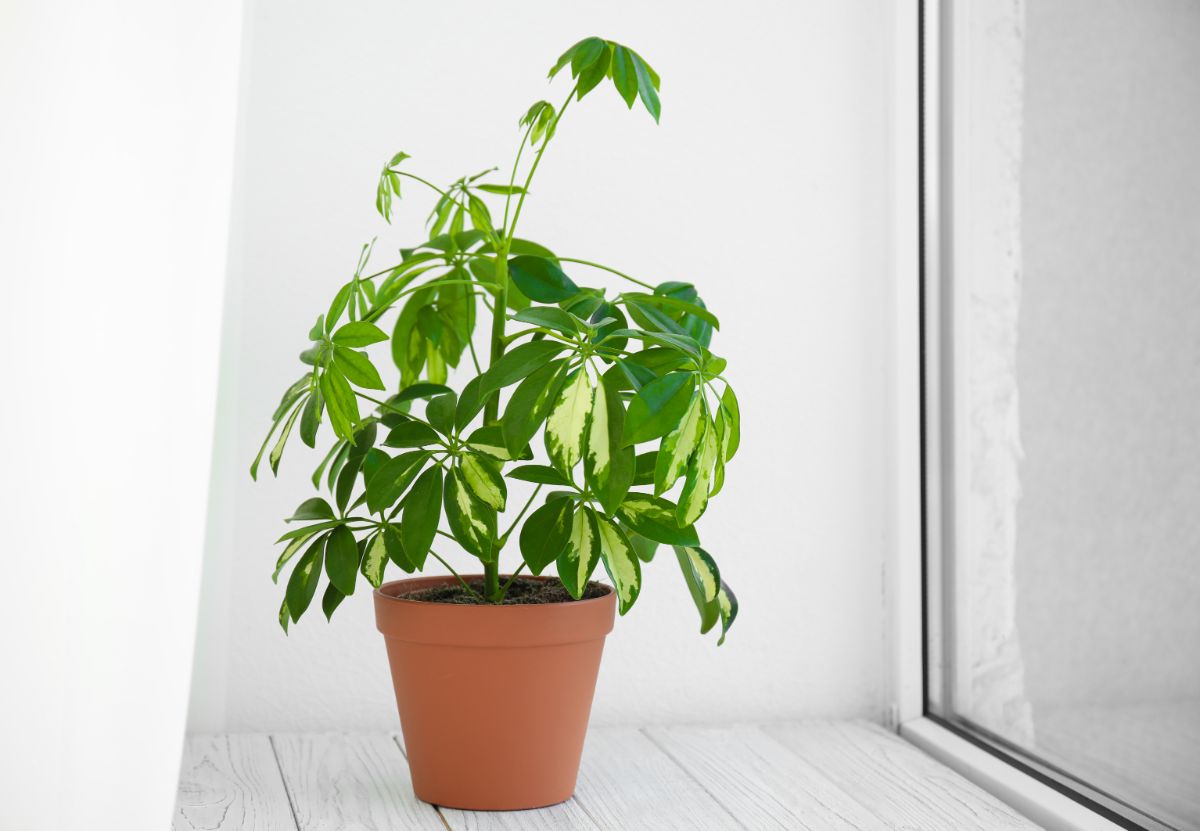
| Plant name: | Dwarf umbrella tree |
| Light requirements: | Bright, indirect light |
| Water requirements: | Moderate |
| Size: | Large |
| Special features: | Unique leaf shape; Great for lobbies |
Dwarf umbrella trees are common sights in office lobbies, but they can be kept as desktop plants too. These plants are named for their unique, whorled leaves that come in both solid green and variegated colorations. When mature, dwarf umbrella trees grow to about 3 to 4’ tall, while standard umbrella trees usually max out at around 10’ high when grown in pots.
Dwarf umbrella trees grow best in bright, indirect light, and they need regular watering. If they are allowed to dry out too much, they will drop leaves and develop bare stems. Pruning can improve the look of spindly plants, or you can move plants outdoors for a while to encourage them to develop a new flush of leaves.
Frequently asked questions

There are a lot of reasons why you may want to add indoor plants to your office. In addition to their beauty, plants can improve indoor air and filter out pollutants. Additionally, caring for plants can boost your mood and improve workplace efficiency.
All plants release oxygen as part of the photosynthesis process; however, some plants are famous for their oxygen-boosting abilities. According to NASA, some of the best plants for air quality include pothos, spider plants, and snake plants.
Yes, you can still keep plants in a windowless office. Overhead fluorescent lights may be able to provide enough light to keep plants happy. However, if you want to boost light levels, you can also add a small tabletop grow light and plug it into a timer to regulate the light your plant receives.
According to some belief systems, certain plants are said to bring luck and prosperity to the workplace. Top choices include jade plants, Chinese money plants, money trees, and lucky bamboo.
Adding plants to your office is an easy way to bring a bit of green into your space. Even if you have a small desk, you can usually find room for a couple of air plants or pothos kept in a vase of water. Many plants can also adapt to low-light rooms, including snake plants and ZZ plants.
While plants may be able to adapt to windowless offices, you’ll want to keep a lookout for signs of light deficiency and be ready to add a grow light if needed. Signs that your plants could use more light include stunted growth, yellow leaves, leggy stems, leaf loss, and stretched-out stems that lean toward the light.
Summary

Whether you work from home or in an office, keeping plants on your desk can brighten up your workspace and help personalize it too. While many indoor plants will work in office settings, choosing low-maintenance species that can handle lower-light environments can make your plant care even easier and set you up for growing success!
The plants we’ve covered today are all excellent, low-maintenance plants that are ideal for work environments. But if you’d like to find more plants for low-light offices or plants that will improve indoor air quality, we have guides on those too!

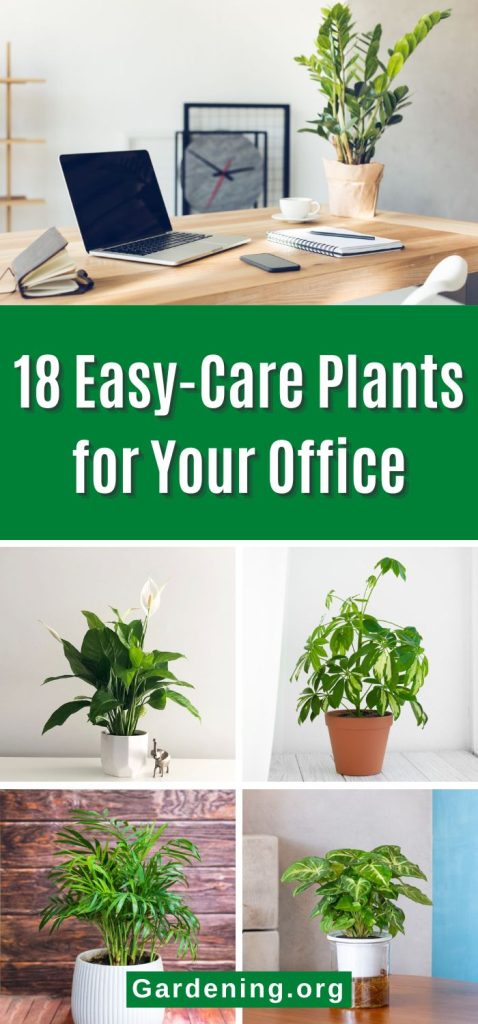

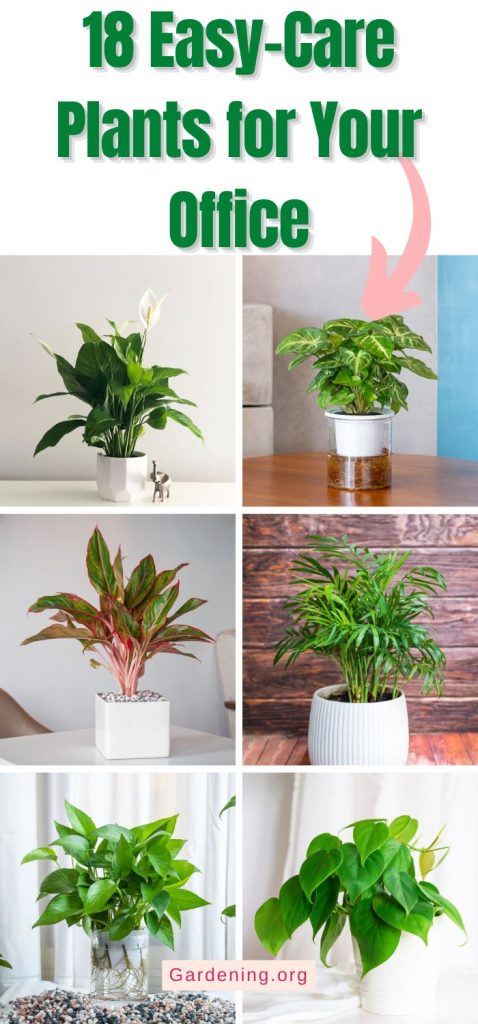

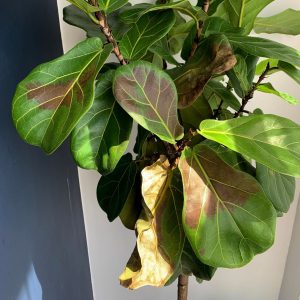
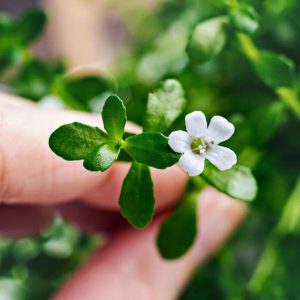
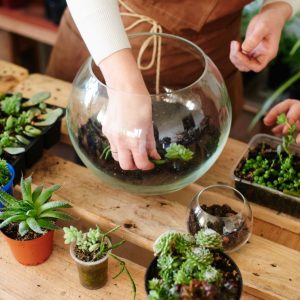
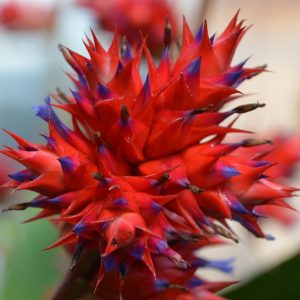
Leave a Reply